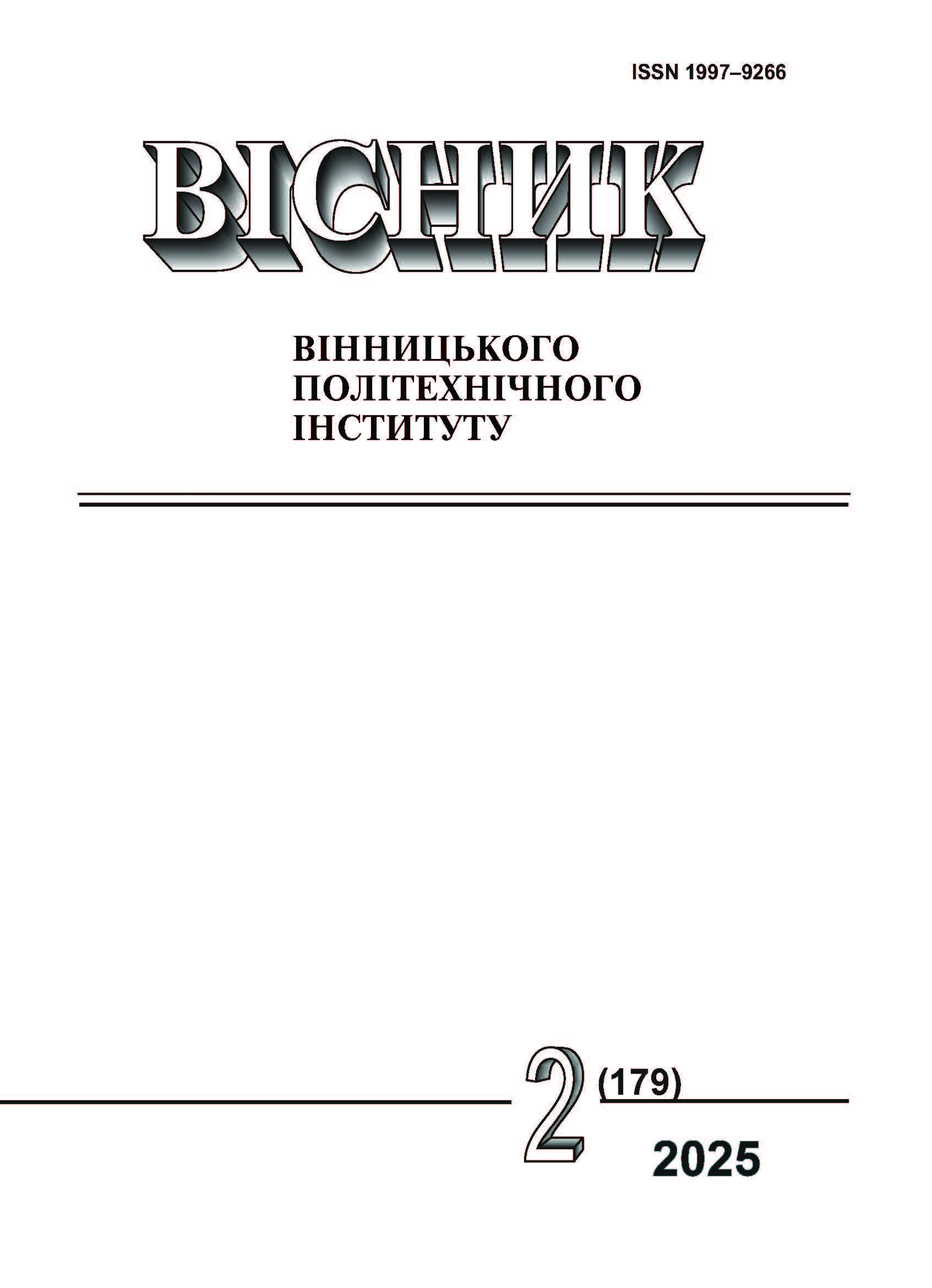ДЕЯКІ АСПЕКТИ КЛАСИФІКАЦІЇ ТЕХНОЛОГІЧНИХ МЕТОДІВ СТВОРЕННЯ РОБОЧИХ ПОВЕРХОНЬ ДЕТАЛЕЙ МАШИН
DOI:
https://doi.org/10.31649/1997-9266-2025-179-2-179-186Ключові слова:
функціональні робочі поверхні, інтелектуальна класифікація, нейромережні моделі, системний аналіз, генетичні алгоритми, багатовимірний параметричний простір, інтеграція CAD/CAM/CAE, експериментальна валідація, формування поверхневого шару, мікрогеометрія поверхні, адаптивне самоналаштування, оптимізація виробничого процесуАнотація
Розглянуто принципово новий підхід до класифікації технологічних методів формування функціональних робочих поверхонь деталей машин на основі поєднання нейромережних моделей та системного аналізу. Актуальність дослідження зумовлена зростанням вимог до експлуатаційних властивостей поверхневого шару — зносостійкості, корозійної стійкості, контактної жорсткості тощо, — що зумовлює необхідність розробки високоадаптивних інтелектуальних систем, здатних автоматизовано вибирати оптимальні технологічні методи з урахуванням різноманітних морфологічних, фізико‑механічних і структурних чинників. Мета роботи полягала в розробці багаторівневої методології класифікації технологічних процесів формування поверхневих шарів з використанням нейронних мереж різного типу та концепції багатовимірного параметричного простору. У межах методології кожен технологічний метод формалізується як вектор параметрів, що включають енергетичні характеристики процесу, вплив на мікрогеометрію поверхні, фізико‑механічні властивості, зміну структурно‑фазового стану та техніко‑економічні показники. Такий підхід забезпечує чітке структуроване представлення взаємозв’язків між характеристиками технологічних методів та їхніми експлуатаційними наслідками. Для валідації відібрано типові деталі : вали, зубчасті колеса, підшипникові кільця та корпусні деталі, — і проведено порівняльний аналіз рекомендацій системи, експертних оцінок та простих критеріальних моделей. Результати показали, що точність вибору методів у розробленій системі зросла на 27…34 % порівняно з традиційними підходами; інтенсивність зношування знизилася на 18…42 %; корозійна стійкість поверхонь підвищилася на 15…35 %. До того ж, швидкість класифікації не перевищувала 1,2 с, що виявилося значно меншим за час роботи аналогічних систем на основі експертних правил та статистичних методів. Однією з ключових переваг є інтеграція з CAD/CAM/CAE‑середовищами, що забезпечує прогноз експлуатаційних властивостей на етапі проєктування. Висока адаптивність системи дозволяє оперативно враховувати нові технологічні рішення та змінювані виробничі умови. Таким чином, запропонована інтелектуальна система класифікації технологічних методів формування функціональних поверхонь є ефективним інструментом для автоматизації вибору оптимальних технологічних рішень, сприяє підвищенню якості та надійності машинобудівної продукції і відкриває перспективи для подальших наукових досліджень і практичних впроваджень у промисловості.
Посилання
H. Linke, J. Börner, and R. Heß, “Load Capacity and Running Performance of External and Internal Gearing,” Cylindrical Gears, Ed. by H. Linke, J. Börner, R. Heß. Munich: Hanser, 2016. pp. 177-457. ISBN 978-1-56990-489-3. https://doi.org/10.3139/9781569904909.006 .
A. Vereschaka, M. Volosova, N. Sitnikov, N. Andreev, F. Milovich, and J. Bublikov, “Filtered cathodic vacuum arc deposition (FCVAD) technology as method for creation of nanostructured multicomponent modifying coatings for wide application range,” Procedia CIRP, vol. 95, pp. 999-1003, 2020. https://doi.org/10.1016/j.procir.2020.01.201 .
J. Taheri Kahnamouei, and M. Moallem, “Advancements in control systems and integration of artificial intelligence in welding robots: A review,” Ocean Engineering, vol. 312, pp. 3. 2024. Article 119294. ISSN 0029-8018. https://doi.org/10.1016/j.oceaneng.2024.119294 .
S. Valizadeh Sotubadi, S. S. Pallissery, and V. Nguyen, “Multi-Modal Explainable Artificial Intelligence for neural network-based tool wear detection in machining,” Engineering Applications of Artificial Intelligence, vol. 144. 2025. Art. 110141. https://doi.org/10.1016/j.engappai.2025.110141 .
K. Qian, L. Zou, Z. Wang, and W. Wang, “Metallic surface defect recognition network based on global feature aggregation and dual context decoupled head,” Applied Soft Computing. vol. 158, 2024. Article 111589. https://doi.org/10.1016/j.asoc.2024.111589 .
Yang Huguang, Zheng Han, and Zhang Taohong, “A review of artificial intelligent methods for machined surface roughness prediction,” Tribology International, vol. 199, 2024. Article 109935. https://doi.org/10.1016/j.triboint.2024.109935 .
С. Ковалевський, «Деякі аспекти застосування штучного інтелекту для відновлення та розвитку України,» Штучний інтелект, № 3, с. 117-125, 2023. http://jnas.nbuv.gov.ua/article/UJRN-0001445551 .
S. Kovalevskyy, “Intelligent control systems for mechanical engineering technology tasks,” Штучний інтелект. Фізико-математичні та технічні науки, міжнар. наук-техн. журнал., № 4 (101), с. 218-227, 2024. https://doi.org/10.15407/jai2024.04.218 .
С. Ковалевський, Д. Сидюк, і О. Ковалевська, «Аспекти впровадження штучного інтелекту в технологічне забезпечення життєвого циклу виробів машинобудування,» Обробка матеріалів тиском, № 1(53), с. 109-115, 2024. https://doi.org/10.37142/2076-2151/2024-1(53)109 .
С. Ковалевський, О. Ковалевська, і Д. Сидюк, «Створення інноваційних виробничих систем машиноремонтного спрямування,» Галицький економічний вісник, т. 86, № 1, с. 115-125, 2024. https://doi.org/10.33108/galicianvisnyk_tntu2024.01.115 .
##submission.downloads##
-
pdf
Завантажень: 39
Опубліковано
Як цитувати
Номер
Розділ
Ліцензія

Ця робота ліцензується відповідно до Creative Commons Attribution 4.0 International License.
Автори, які публікуються у цьому журналі, згодні з такими умовами:
- Автори зберігають авторське право і надають журналу право першої публікації.
- Автори можуть укладати окремі, додаткові договірні угоди з неексклюзивного поширення опублікованої журналом версії статті (наприклад, розмістити її в інститутському репозиторії або опублікувати її в книзі), з визнанням її первісної публікації в цьому журналі.
- Авторам дозволяється і рекомендується розміщувати їхню роботу в Інтернеті (наприклад, в інституційних сховищах або на їхньому сайті) до і під час процесу подачі, оскільки це сприяє продуктивним обмінам, а також швидшому і ширшому цитуванню опублікованих робіт (див. вплив відкритого доступу).





